1 in 6 people
are estimated to have been exposed to conflict so far in 2024
i
A population is classed as exposed if it is within 5km of a political violence event
50 countries
rank in the index categories for extreme, high, or turbulent levels of conflict
i
All countries receive an Index score and 50 meet the top three categories
Ukraine, Myanmar, Mexico, and Palestine
top each of the four indicators
i
22% increase
in political violence incidents recorded in the past 5 years
i
Increase in total number of conflict events from 2019-2023.
Methodology
- About
- Indicators
- Definitions & Data Sources
- Rankings
The ACLED Conflict Index uses four indicators to measure conflict levels: deadliness, danger, diffusion, and fragmentation. The values for each indicator are calculated for each country or territory, scaled, and ranked. The top ranked countries overall are experiencing the most severe, complex, and difficult-to-resolve conflicts.
Countries often host multiple discrete conflicts, which can be an accumulation of actions by several armed groups. These groups often have differing political aims, trajectories, and life spans. The Index accounts for all conflicts occurring within countries by examining their combined incidents of violence.
Countries with high incident totals or high conflict fatalities are highly violent and deadly. But incident and fatality counts when evaluated on their own – isolated from aggravating factors and local context – can often distort the size and impact of conflict for different communities and governments. Further, conflicts that have similar rates of intensity are rarely similar in other ways. In Haiti and the Philippines, for example, the conflict event rate is consistent (close to 700 political violence events per year), but the violence impacts their respective communities and governments in very different ways. Conflicts can also differ with respect to the risks faced by different communities. For example, a civilian in Mexico is currently twice as likely to be killed by political violence as a civilian in Syria.
The ACLED Conflict Index is designed to first distinguish conflict risk factors by deadliness, danger, diffusion, and fragmentation, and then to create a relative country ranking based on the combined intensity of risks.
The first version of the Index was launched in January 2023, and an expanded version based on an updated methodology was released in September 2023.
All countries and territories are assessed according to each indicator. Countries are then ranked by their scores for each indicator. See below the table for maps showing the current top 25 countries for each indicator.
| Indicator | Measure | Significance |
|---|---|---|
| Deadliness | How fatal are political violence events? |
The amount of political violence-related fatalities can indicate
how intense conflict is within a state. The Deadliness indicator represents the number of reported fatalities per country in the 12 months preceding the latest update of the Index (e.g. July 2022-July 2023 for the mid-year Index update). |
| Danger | How many political violence events are targeted towards civilians? |
Conflicts differ with respect to how much armed groups —
including state actors – prey on civilians. Conflicts that have
a higher rate of civilian violence are likely to continue and
proliferate, in part because armed groups are not facing more
active resistance from other armed entities. The Danger indicator represents the number of violent events targeting civilians per country in the 12 months preceding the latest Index update. |
| Diffusion | What proportion of the country experiences a high level of violence? |
Many conflicts can occur in a country simultaneously, adding to
the geographic spread of conflict across states. This measure is
an assessment of the geographic distribution of conflict. Each
country is divided into a 10km-by-10km spatial grid. Grid cells
that have a population of fewer than 100 people are excluded.
Next, ACLED determines how many of a country’s geographic grid
cells experience a high level of violence, defined as at least
10 events per year (representing the top 10% of cases).
The Diffusion indicator represents the proportion of high violence grid cells to total cells (i.e. the percentage of geographic area experiencing high levels of violence) |
| Fragmentation | How many non-state armed, organized groups are operating within the conflict? |
The fragmentation of a conflict environment indicates the number
of distinct threats and agendas that are accumulating in a given
context and posing harm to communities and state institutions.
It also indicates the number of distinct political motives and
opportunities to form an armed group. A singular consolidated
armed group can be a serious challenge to governments, but it
can also take part in effective negotiations and engagements. A
highly fragmented environment, in contrast, makes it more
difficult to engage the necessary actors in effective
negotiations and may indicate multiple overlapping conflicts
that are more challenging to simultaneously resolve. The Fragmentation indicator is a count of all armed, organized, active rebel and political militias per country in the last 12 months (excluding unidentified armed groups and including pro-government militias). In addition, a maximum of one communal militia is counted per first level administrative unit per country. |
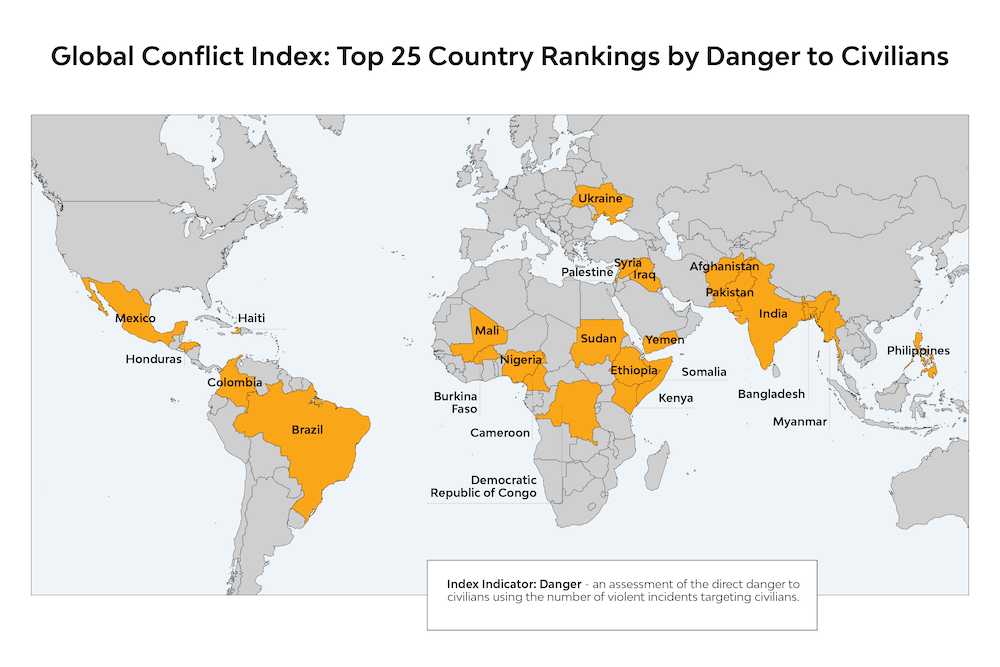
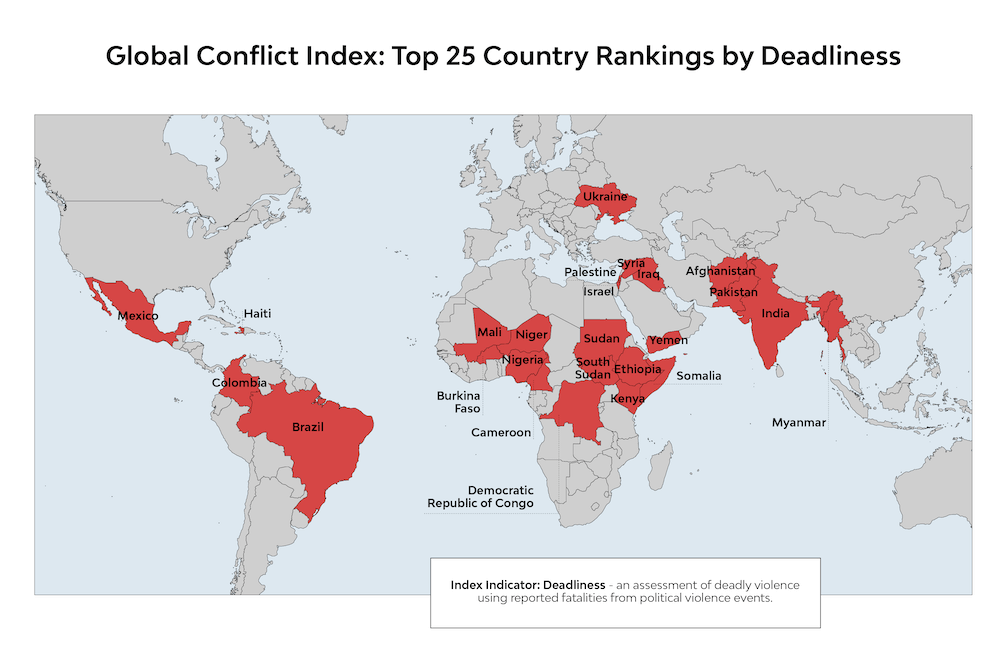
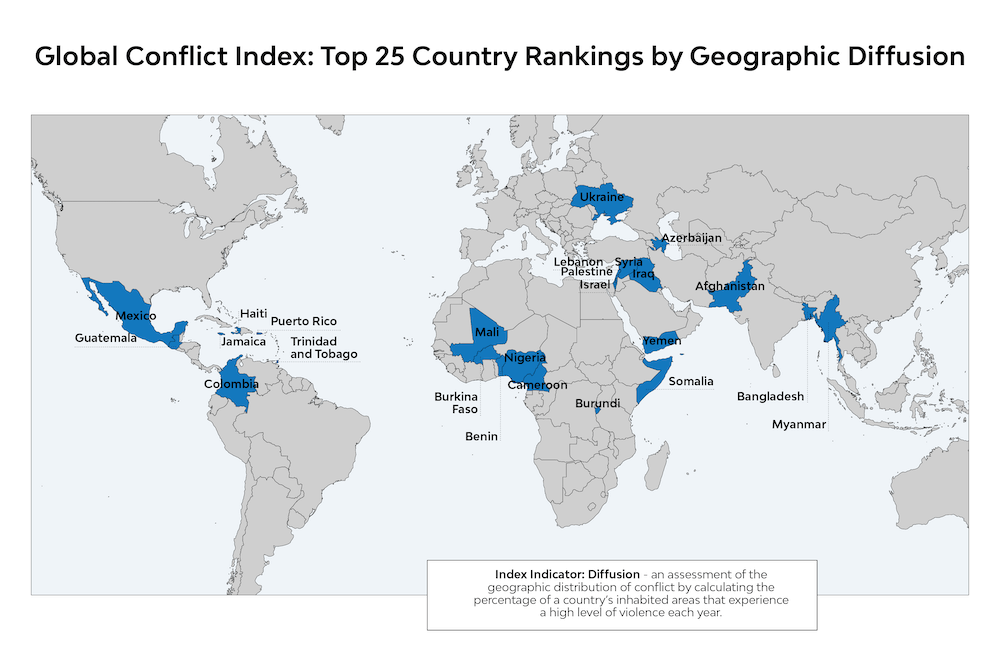

Definitions
In alphabetical order:
Cartels: Organized armed groups that do not seek to topple the state, but rather seek to control territory for the purpose of extracting exclusive economic benefits via illicit activities.1Lessing, B. (2015). "Logics of Violence in Criminal War." Journal of Conflict Resolution 59.8: 1486-1516. Examples include the Sinaloa Cartel in Mexico.
Event: The fundamental unit of observation in ACLED is referred to as the “event.” Each coded event involves at least one designated actor – e.g. a named rebel group (or, in some cases, an unidentified group), the type of action carried out, a specific named location, a specific date, and other key variables. ACLED currently codes for six event types and 25 sub-event types, both violent and non-violent, that enable analysis of patterns of political violence and demonstration activity.
Executions/Assassinations: The killing of ruling elites, prominent members of society, or important political figures and dissidents. Examples include the assassination of political elites in Yemen and the assassinations of social leaders in Colombia during the COVID-19 pandemic.
Fatalities: In ACLED analysis, the use of the term "fatalities" always refers to reported fatalities recorded in the dataset, per the ACLED fatality methodology.
Gangs: Organized criminal groups whose violent actions (e.g. battles and varied violence against civilians) can have clear political consequences despite a lack of an overt political agenda. They commonly cooperate with local elites and participate in income-seeking behavior, but vary in the degree to which they are organized and at what scale they operate. Examples include the Red Command in Brazil.
Gang Violence: Violence committed by criminal groups without an overt political agenda, also known as gangs (see above). Gang violence is only captured in the ACLED dataset in certain circumstances that have been determined to meet the parameters for inclusion based on the country-context, as outlined in the ACLED methodology brief, Gang Violence: Concepts, Benchmarks, and Coding Rules.
Insurgency: This term refers descriptively to violent activity carried out by an organized, armed, non-state group or groups internally against a governing authority, often to contest control over a territorial area. The use of the term is highly context-specific, and the aims, ideology, intensity, size, and geographic scope of insurgencies will vary.
Militias: The ACLED dataset categorizes two types of militia, political militias and identity militias, and acknowledges the actions of pro-government militias.
- Political Militias: Armed, organized groups with political goals that use violence to advance those goals. Unlike rebel groups, political militias generally do not actively seek to topple or replace the national government using violence, though some are organized in opposition to government authority (e.g. anti-government militias in the United States that at times shift orientation based on the dominant national party or president). These groups often cooperate or ally with various domestic elites as well as external forces, albeit typically without a formal link. Examples include Loyalist militias in Northern Ireland, far-right militias and militant social movements in the United States (such as the Three Percenters or the Proud Boys), and the Bakassi Boys in Nigeria.
- Identity Militias: Armed and violent groups organized around a collective, common feature including community, ethnicity, region, religion, or, in exceptional cases, livelihood. Therefore, identity militias captured in the ACLED dataset include those reported as tribal, clan, communal, ethnic, local, community, religious, and livelihood militias. Violent events involving identity militias are often referred to as communal violence, as these violent groups frequently act locally, in the pursuit of local goals, resources, power, security, and retribution. An armed group claiming to operate on behalf of a larger identity community may be associated with that community, but not represent it (e.g. Luo Ethnic Militia in Kenya or Fulani Ethnic Militia in Nigeria). Recruitment and participation are according to association with the identity of the group. For more, see ACLED Codebook section on Actors.
Mob Violence/Vigilantism: Extrajudicial violence in response to crimes, real, perceived, or not yet committed.2Bateson, R. (2021). "The Politics of Vigilantism." Comparative Political Studies 54.6: 923-955. This can also include the use of violence to punish social infractions or deviations from social norms. Examples include lynchings in Port au Prince, Haiti, or South Africa, as well as pandemic-related attacks against healthcare workers in India.
Organized Criminal Violence: Organized crime is the use of violence by highly organized groups in order to control (often illegal) markets and extract economic benefits. Resources that can motivate such violence can include timber, drugs, diamonds, minerals, and more. The designation of violence in this form is not based on the size of the organization or its scope. Organized violence can be localized but networked over larger spaces - such as the Mafia violence of Southern Italy;or specifically relating to a locality or entire region, such as the various agents and groups engaged in the Mexican drug war.
Political Violence: The use of force by a group with a political purpose or motivation. In analysis, this is a category used to refer collectively to ACLED’s 'Violence against civilians', 'Battles', and 'Explosions/Remote violence' event types, as well as the 'Mob violence' sub-event type of the 'Riot' event type and the 'Excessive force against protesters' sub-event type of the 'Protests' event type. For more, see the ACLED Codebook.
Rebels: Armed, organized non-state actors that seek to challenge and topple or replace the government through the use of violence. These actors are also commonly referred to as insurgents or guerrilla fighters. They commonly coordinate with external forces and political militias/gangs. Examples include the Islamic State in the Greater Sahara, Allied Democratic Forces in the Democratic Republic of Congo and Uganda, and Southern Transitional Council armed forces in Yemen.
Rioters: Individuals who engage in violence during demonstrations and mob violence events. Violence can be directed against people, property, or both. Examples include the 2020 Delhi riots in India and riots against COVID-19 restrictions.
Vigilantes/Mobs: A group of individuals engaging in extrajudicial violence meant to punish a crime, perceived crime, or social infraction.3Bateson, R. (2021). "The Politics of Vigilantism." Comparative Political Studies 54.6: 923-955. Examples include mobs engaging in the justicia comunitaria lynchings in Bolivia, especially within Indigenous communities, and lynching mobs in Bangladesh.
Violence Targeting Civilians: A category that encompasses all events of political violence that target civilians. This includes a broader scope than the violence against civilians event type ('Sexual violence', 'Attack', and 'Abduction/Forced disappearance' sub-event types). It is inclusive of the aforementioned sub-event types, the 'Excessive force against protesters' sub-event type, as well as 'Explosions/Remote violence' and 'Riots' event types which involve civilians or protesters, but excludes the 'Peaceful protest' and 'Protest with intervention' sub-event types. Violence targeting civilians is typically used in ACLED analysis because it reflects the widest scope of violence faced by civilians recorded in the dataset.
Data Sources
ACLED data on political violence from the 12 months preceding the latest version of the Index are used to create the four indicators (e.g. December 2022 to December 2023). All ACLED events are collected using the same methodology, allowing a comparison of event numbers for political violence. Political violence events include the ‘Battles’, ‘Explosions/Remote violence’, and ‘Violence against civilians’ event types, as well as the ‘Mob violence’ and ‘Excessive force against protesters’ sub-event types.
Figures on exposed populations are derived using data from WorldPop.
To determine the overall ranking of countries in the Index, ACLED first ranks each country within each of the four indicators. An average ranking is calculated for each country based on those composite rankings, forming the final, overall ranking of the Index.
A country’s overall ranking on the Index determines its level of conflict. The top 10 countries in the Index are in the ‘extreme’ category, followed by the next 20 countries in the ‘high’ category, and finally the next 20 countries are in the ‘turbulent’ category. The remaining countries are in the ‘low/inactive’ category.
The 50 countries and territories in the ‘extreme’ to ‘turbulent’ categories account for 97% of all political violence events recorded by ACLED. The remaining 3% of political violence events are distributed across 117 other countries and territories.
How much conflict is occurring in the world as of January 2024?
Conflict is now widespread and pervasive: 12% more conflict occurred in 2023 compared to 2022, and ACLED records an increase of over 40% compared to 2020. One in six people live in an actively conflicted area. In 234 countries and territories covered by ACLED, the majority — 168 — saw at least one incident of conflict in 2023. Over 147,000 conflict events are recorded, and at least 167,800 fatalities.
Conflicts differ in their intensity, frequency, and form. For that reason, comparing event numbers may distort comparisons. Drawing on the latest data and patterns, the 2024 update to the ACLED Conflict Index assesses levels of conflict according to four key indicators: deadliness, danger to civilians, geographic diffusion of conflict, and armed group fragmentation.
Countries are ranked within each of these four indicators, and those positions determine the overall ranking on the Index (see Methodology sidebar for more). A country’s place on the Index represents its conflict level compared to other countries.
Conflict rates exist on a spectrum, and some level of conflict occurs in almost every country. The highest levels are found in the 50 countries highlighted in the Index list. These countries are categorized as ‘extreme,’ ‘high,’ or ‘turbulent.’ These top 50 ranked countries account for 97% of all conflict events recorded for the past 12 months. The extremely violent countries account for 40% of all conflict.
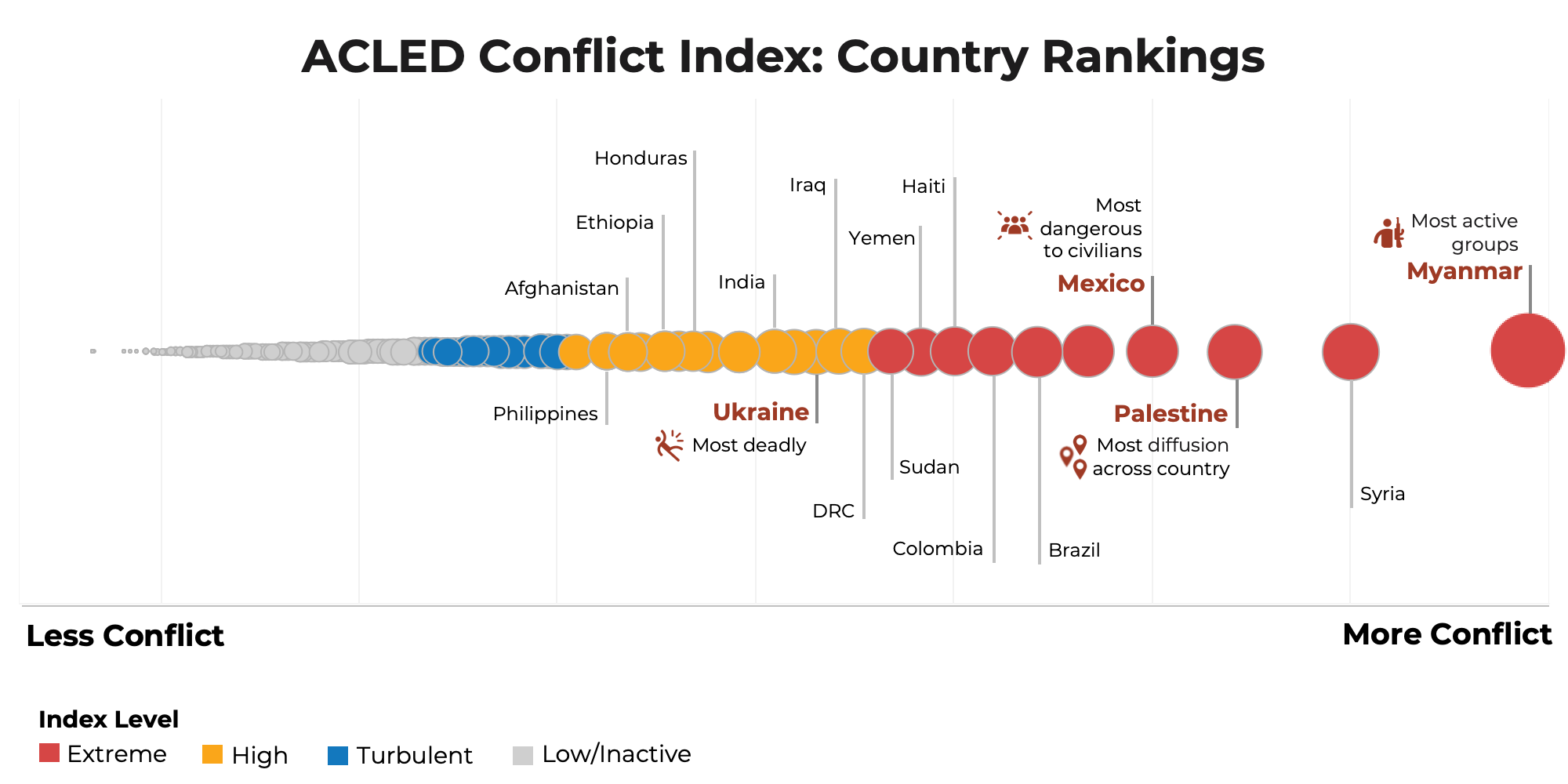
Of those 50 countries, Myanmar is the most violent overall and retains its position as the most ‘fragmented’ due to its hundreds of small militias formed to contest the government since the coup in 2021. Syria is the second most conflicted country due to multiple, overlapping conflicts which continue to occur within its borders. Palestine has conflict covering almost all of its territories and therefore ranks as the most ‘diffuse’ conflict. Palestine’s position rose since the last Index, entirely due to the extensive and deadly war with Israel primarily fought in Gaza. Mexico continues to be the most dangerous country for its citizens, as they are directly targeted by cartels in their violent competitions. Ukraine remains the most deadly as the armies on both the Ukrainian and Russian sides have lost tens of thousands of fighters — although, in the time since 7 October, Gaza specifically has the most overall fatalities.
Where is conflict happening as of January 2024?
The 50 most violent countries and their rates of change are listed below. Of those countries with extreme violence, two are in Africa (Nigeria and Sudan), and Sudan continues to get worse as mass killings are a key feature of that conflict. Three countries are in the Middle East (Palestine, Yemen, and Syria), underscoring the depth of problems that persist in the region across decades. Myanmar is the sole Asian country with extreme violence, but it remains the most difficult conflict case in the world. Finally, four of the 10 extremely violent places are in Latin America (Mexico, Brazil, Colombia, and Haiti); barring Haiti, all are also considered relatively stable democracies and market economies despite being riddled with gangs, contested authorities, corruption, and violence against civilians. There are no large, traditional wars in these countries, but multiple, deadly, pervasive small conflicts.
These small conflicts and their characteristics continue to be the most persistent feature of instability across developing and more-developed countries. A key feature of these conflicts is the number of armed groups, and their agendas: several thousand militias and gangs operate across these conflicts, and their goals are often local authority and control. They do not seek to govern, speak for maligned or excluded groups, or transform the political system to be more democratic, fair, or representative. They are locked into a contest for power, where violence is the most effective tool available to them.
Click each column to sort results in the table below.
| Rank | Country | Index Level | Change Category | Change Rate |
|---|---|---|---|---|
| 1 | Myanmar | Extreme | Consistently concerning | 0 |
| 2 | Syria | Extreme | Consistently concerning | 0 |
| 3 | Palestine | Extreme | Worsening | |
| 4 | Mexico | Extreme | Consistently concerning | |
| 5 | Nigeria | Extreme | Consistently concerning | 0 |
| 6 | Brazil | Extreme | Consistently concerning | 0 |
| 7 | Colombia | Extreme | Consistently concerning | |
| 8 | Haiti | Extreme | Worsening | |
| 9 | Yemen | Extreme | Consistently concerning | |
| 10 | Sudan | Extreme | Worsening | |
| 11 | Democratic Republic of Congo | High | Improving | |
| 12 | Iraq | High | Improving | |
| 13 | Ukraine | High | Improving | |
| 14 | Pakistan | High | Consistently concerning | |
| 15 | Mali | High | Consistently concerning | 0 |
| 15 | India | High | Consistently concerning | |
| 17 | Burkina Faso | High | Consistently concerning | |
| 17 | Bangladesh | High | Consistently concerning | |
| 19 | Kenya | High | Consistently concerning | |
| 20 | Honduras | High | Consistently concerning | 0 |
| 21 | Jamaica | High | Consistently concerning | |
| 22 | Ethiopia | High | Consistently concerning | |
| 22 | Israel | High | Worsening | |
| 24 | Guatemala | High | Consistently concerning | |
| 25 | Cameroon | High | Consistently concerning | |
| 25 | Afghanistan | High | Consistently concerning | |
| 27 | Somalia | High | Consistently concerning | |
| 27 | Philippines | High | Consistently concerning | |
| 27 | Venezuela | High | Consistently concerning | 0 |
| 30 | Trinidad and Tobago | High | Consistently concerning | |
| 31 | Lebanon | Turbulent | Consistent | |
| 32 | Burundi | Turbulent | Consistent | |
| 33 | South Africa | Turbulent | Consistent | |
| 34 | Niger | Turbulent | Improving | |
| 34 | Central African Republic | Turbulent | Consistent | 0 |
| 36 | Russia | Turbulent | Consistent | |
| 37 | South Sudan | Turbulent | Consistent | |
| 38 | Madagascar | Turbulent | Worsening | |
| 39 | Puerto Rico | Turbulent | Consistent | |
| 40 | Ecuador | Turbulent | Consistent | |
| 41 | Turkey | Turbulent | Consistent | |
| 42 | Uganda | Turbulent | Consistent | |
| 43 | Benin | Turbulent | Consistent | |
| 44 | Indonesia | Turbulent | Consistent | |
| 45 | Mozambique | Turbulent | Consistent | |
| 46 | Iran | Turbulent | Consistent | |
| 47 | Belize | Turbulent | Worsening | |
| 48 | Zimbabwe | Turbulent | Worsening | |
| 49 | Chad | Turbulent | Consistent | |
| 50 | Papua New Guinea | Turbulent | Worsening |
What does the Index tell us?
The world is getting far more violent in recent years: conflict event rates have increased by over 40% from 2020 through 2023; and increased 12% in 2023 from 2022 rates. But 2020 was a relatively less violent year compared to 2018-2019, when wars in both Afghanistan and Syria raged. Compared to those years, the increase in 2023 is still significant at an average of 20%.
Is conflict worsening or improving?
As of January 2024, 15 countries have seen improvements to their Index rankings during the five-year period between 2019 and 2023, and 16 have seen worsening levels of conflict. Sixteen countries have remained in the ‘extreme’ or ‘high’ conflict level categories consistently, with no change between 2019 and 2023. Overall, of the 50 countries ranked at the top of the Index, over half (42) are experiencing sustained or escalating levels of conflict compared to 2019.
In the six months between the mid-year update of the Index (July 2023) and the end of the year, eight countries have seen worsening levels of conflict, with three of those countries – Palestine, Haiti, and Sudan – moving into the ‘extreme’ conflict level category.
Ukraine decreased on the list. Why?
Ukraine’s position on the Index has decreased for two reasons. First, there are remarkable levels of stagnation in the Ukraine conflict, including in fatalities, active locations, and the fighting parties. Ukraine’s conflict is currently in a stage of attrition, with no sign of ending, and very little sign of change. Second, conflict in other countries is rising in multiple ways: in event frequency, conflict groups, and location under active conflict. While Ukraine’s conflict rate has stayed relatively stable and consistent, continued increases in other countries mean that it falls from ‘extreme’ to ‘high.’
Conflict rates and media attention are not correlated. Why?
Many conflicts do not garner sufficient attention, no matter how violent. These include Myanmar and Syria, which have ranked as the most violent countries in the Index for a year. In both cases, the conflicts are multiple, complicated, and enduring. Myanmar’s armed group resistance against the military junta persists, while Syria continues to battle with continuing violence in Idlib (the last anti-government holdout); continued Islamic State attacks in the east; Turkey attacking Kurdistan Workers’ Party (PKK) fighters in the north; Iraqi resistance forces attacking United States bases; Israeli strikes in Damascus; and continuing unrest in smaller corners of the country.
There are several reasons why conflict rates and media attention are not matched: first, media attention is most frequently centered on conflicts that are internationally or ‘geopolitically’ relevant, meaning they have a resonance beyond the borders of the country in conflict, or they involve at least two governments (rather than internal conflicts).
The media covered both Gaza and Ukraine extensively because of the widespread interest in these conflicts and the threat of larger violence emanating from these contests. In Gaza, the conflict between Israel and Hamas is intense, very damaging for the population of Gaza, and has regional ramifications. Many journalists have been killed in bombings, but widespread coverage continues of Israeli activity. In Ukraine, the conflict involving Russia’s invasion of its sovereign neighbor has significant future implications for NATO and the European Union, other countries in Russia’s ‘near abroad,’ and the ability to prevent future invasions by a marauding state.
Second, most complex conflicts are difficult to report on, and increasingly, internal conflicts have multiple armed groups, competing agendas, and variable violent strategies. Many of the conflicts we see in the most extreme categories violate our typical understandings of conflict as civil wars, insurgencies, or terrorist events. Conflicts in Mexico, Brazil, and Colombia are complicated by cartels, pro-government gangs and anti-government groups: these groups are not trying to overtake the government or control territory to govern. They engage with the local police, and when they target government officials, it is often administrators like mayors and councilors. These militias seek to benefit from the existing political structure, and aim to have economic and social control over places and populations. The countries in both the ‘extreme’ and ‘high’ Index categories are very violent because so many of these militia groups exist, exposing large populations to violence in their competition between each other and civilians. While the media often expects revolution and mass repression from internal conflicts, most political violence looks very different.
Third, the threat to the media in some conflicts prevents full coverage, and victims, local organizations, or even governments provide information on the activities within conflicts. Not all conflict information is comparable in coverage, fairness, or accuracy, even when the environment allows for the free flow of information. The interest — and even biases — of audiences shape what kinds of information we receive.
How have conflicts changed?
Conflicts have become complex in some common ways.
There are few large, traditional wars now being fought, but many countries with several overlapping, concurrent conflicts.
The forms of conflict that are the most common around the world look more like the violence patterns in Mexico and Myanmar, and are less like traditional insurgencies where one group wrestles with a government for control or territory. They also host multiple conflicts that differ in both targets and intended outcomes, and these conflicts do not often overlap. This means that governments frequently find themselves fighting multiple conflicts at once, and communities are exposed to varied types of violence.
Violence in countries experiencing ‘extreme’ and ‘high’ conflict levels typically also involves many active armed, organized groups. These groups fight each other as frequently as they clash with government security forces. Militias, rather than rebels, increasingly play a leading role in these conflicts.
Conflict is growing fastest in middle-income, democratizing countries. Middle-income countries are experiencing the greatest rise in conflict. Poverty is not a precursor to conflict, and wealth is not a guarantee of peace. In the graphic below, the top 50 countries in the ACLED Conflict Index are placed across the UN Human Development Index. As this comparison demonstrates, many countries with ‘extreme’ or ‘high’ levels of conflict are places with high and sustained levels of economic and social development.
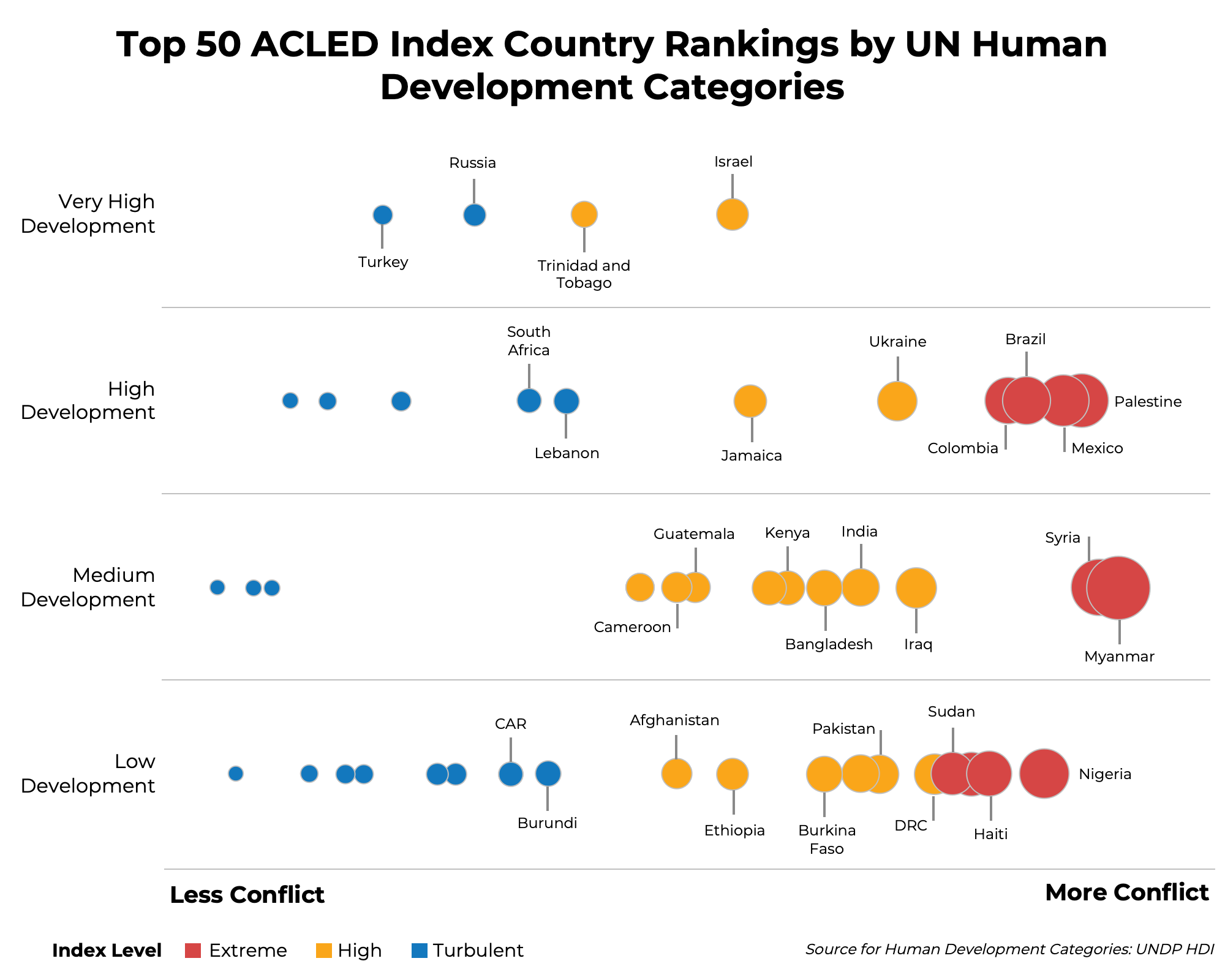
Democracy does not protect countries from violent politics. In countries transitioning to democracy or regressing from democracy, new forms and contenders of political competition encourage conflict. Democratic shifts across the world have reduced the likelihood of traditional civil wars and increased the likelihood of militia activity and political violence. Countries with “partly free” systems, according to Freedom House classifications, have elections, leader turnover and removal, inclusive representation, and other features of democracy, but often experience high levels of political violence, as shown in the graphic below.
There will be an unprecedented number of elections in 2024, and over half the world’s population will participate in, or live in, a country experiencing an election. This will give rise to violent attacks against civilians and more targeted assaults and killings of local officials by armed groups.
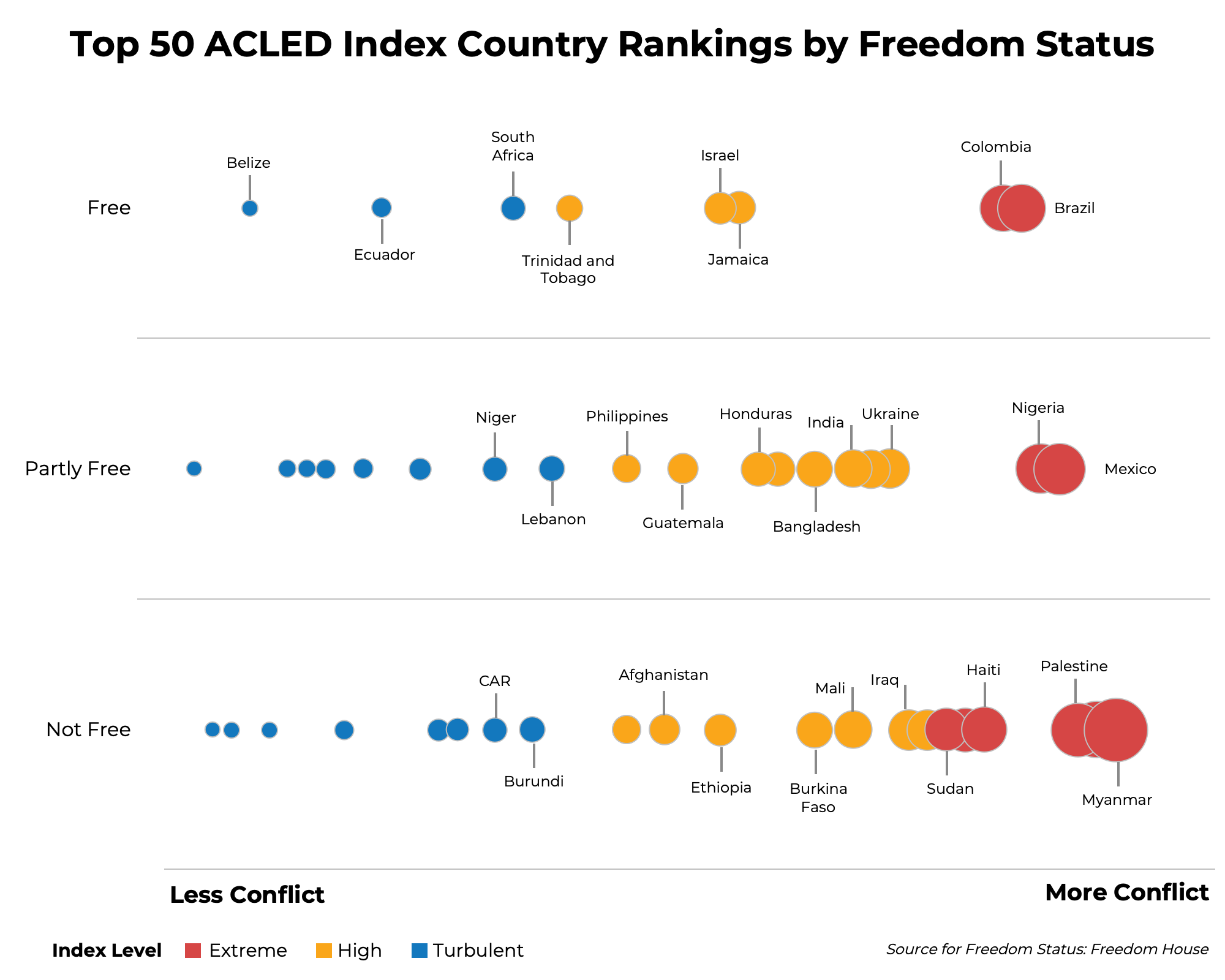
Can the Index suggest what is to come?
In the past, this Index has highlighted a country’s conflict position as ‘worsening,’ and confirmed its increasing instability in subsequent updates. For example, in July, Palestinian territories were noted as in ‘high’ conflict and having the world’s most extensive and diffuse violence; in this updated Index, Palestine is now ‘extremely’ violent.
The Index aggregates several characteristics of violence that are sensitive to change, and this allows us to robustly assess the likely trajectory of conflict. For example, the current Index suggests that Sudan and Haiti will likely worsen in the following six months, and Nigeria may improve. Yemen and Mexico are also likely to worsen.
ACLED produces monthly conflict forecasts at the national and subnational level in our Conflict Alert System (CAST). This system is highly accurate as to the trajectory of events in very violent countries. For example, on average over the last 6 months, CAST has predicted the number and type of events within 4% accuracy in half of the ‘extreme’ category countries: Brazil, Mexico, Yemen, Nigeria and Colombia.
Visit the ACLED Conflict Index home page for more information and other reports.
Downloads & Tools
Access a data file with ACLED Conflict Index results for all countries and territories, including Index level, overall Index ranking, and each individual Index indicator score. To access the underlying ACLED event data, use our data export tool or curated data files.
Interactive Conflict Index Dashboard
For more information about past and present Index results, use our interactive dashboard to access additional tools, resources, and data downloads. Use of the tool requires registration for a free account.


